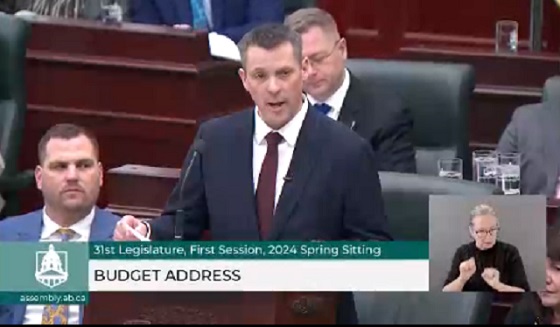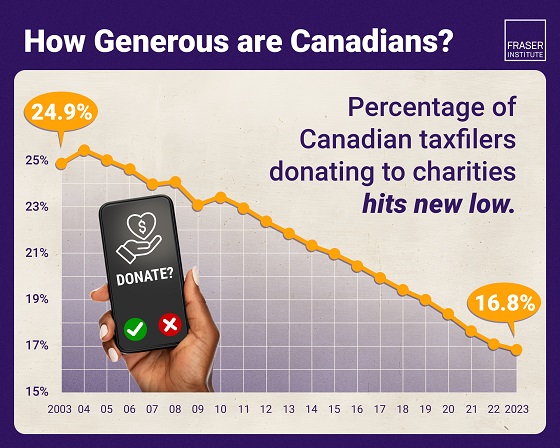Alberta
New tax bracket among features of Alberta’s 2024 Budget

Budget 2024: A responsible plan for a growing province
Budget 2024 is a responsible plan to strengthen health care and education, build safe communities and manage resources wisely to support a growing Alberta.
With a steady focus on fiscal responsibility and wise spending, Alberta’s government will continue to meet the needs of Albertans today and tomorrow. Budget 2024 presents three more years of balanced budgets, beginning with a forecast surplus of $367 million in 2024-25. Budget 2024 strengthens the vital services Albertans rely on and ensures those services remain sustainable over the long run.
“Alberta is growing. Budget 2024 is a plan that manages the pressures faced by a growing province today while securing the future for generations who follow. I’m proud of the choices we made in this budget that support Albertans’ top priorities and prepare our province to meet the challenges that lie ahead. Budget 2024 invests today and saves for tomorrow so we can continue to be the nation’s economic engine.”
Budget 2024 is a responsible plan that puts Albertans and Alberta families first by investing in their health, education, safety, and economic growth and success. Priority investments include:
- Health and mental health supports: $26.2 billion in operating dollars, a 4.4 per cent increase over the forecast for 2023-24.
- Education supports: $9.3 billion in operating expenses, a 4.4 per cent increase from last year, to support record enrolment growth, hire hundreds more education staff including teachers and educational assistants, and support students with specialized needs.
- Social supports: $2.9 billion in 2024-25 to Albertans through the Assured Income for the Severely Handicapped program, the Alberta Seniors Benefit and other social support programs, plus $355 million for Alberta Child and Family Benefit payments to help low-income families, indexing payments to inflation and providing for more eligible clients.
- Workforce supports: An increase of $102 million over three years to add 3,200 apprenticeship classroom seats in high-demand areas and support curriculum updates to the apprenticeship program, as well as $62.4 million over three years to expand physician education, including through rural health training centres.
- Public safety supports: $1.2 billion in 2024-25 operating expense for Public Safety and Emergency Services to support police and mental health crisis teams, deploy street-level police officers to tackle crime in Calgary and Edmonton, and provide $74 million to the Alberta Emergency Management Agency.
- Wildfire supports: $151 million operating expense over the next three years for enhancements to the Wildfire Management Program and $55 million in capital investment for new firefighting equipment and facilities.
- The fiscal framework provides the flexibility the government needs to respond quickly to disasters and emergencies as they arise, including a $2-billion contingency.
- Water management and drought preparedness supports: $1.3 billion in capital funding over the next three years, including $251 million to better prepare the province for floods and droughts; $272 million for irrigation projects; and $539 million to support municipal water supply and wastewater infrastructure.
- Budget 2024 also provides additional operating support of $19 million over three years for the Strategy to Increase Water Availability and $9 million for water management initiatives.
- Capital supports: In total, $25 billion over three years in capital funding to build schools, hospitals, roads and other infrastructure, supporting 24,000 direct jobs and 13,000 indirect jobs across the province.
Alberta is well-positioned to remain the economic engine of Canada, with real gross domestic product forecast to grow 2.9 per cent in 2024, but the province continues to face challenges. While Alberta’s growing population is supporting economic activity and helping to ease labour shortages, it is also increasing demand for housing, health care, education and other public services. Ongoing geopolitical turmoil, uncertainty from federal government policies and high consumer prices risk dampening growth. Budget 2024 prepares Alberta to face those headwinds, with its responsible plan that invests in Albertans today and builds prosperity for tomorrow.
The fiscal framework introduced in spring 2023 requires the government to use at least half of any available surplus cash to pay down debt, freeing up more money to support Albertans. Taxpayer-supported debt will be reduced by a forecast $3.2 billion in the 2023-24 fiscal year. With the government’s commitment to paying down debt, the total taxpayer-supported debt will be $78.4 billion at the end of 2024-25.
High interest rates and the need to refinance maturing debt are driving up debt-servicing costs (the interest payments and fees on the debt) paid by taxpayers. As a result, debt-servicing costs are growing by $229 million in 2024-25 to $3.4 billion. While high interest rates on refinanced maturing debt are driving up those costs in the short term, the government’s strategic debt repayment plan will save Albertans millions in the long term.
The province is retaining more than $1 billion in investment earnings from 2023-24 in the Alberta Heritage Savings Trust Fund. Alberta’s government will also deposit another $2 billion from the Alberta Fund, increasing the value of the Heritage Savings Trust Fund to a forecast $25 billion. This is a significant investment in the future of Albertans and the province’s main long-term savings fund
Revenue
- In 2024-25, total revenue is estimated to be $73.5 billion, which is $2.1 billion lower than the third-quarter forecast for 2023-24.
- Revenue from personal income taxes is estimated to increase to $15.6 billion in 2024-25, up $365 million from the third-quarter forecast, and grow in the following two years as more people continue to move to Alberta.
- Corporate income tax revenue is estimated at $7 billion in 2024-25, down $176 million from the third-quarter forecast for 2023-24, but rising over the next two years.
- Non-renewable resource revenue is estimated to drop to $17.3 billion in 2024-25, from $19.4 billion forecast for 2023-24, and is forecast to pick up over the medium term.
Expense
- Total expense in 2024-25 is $73.2 billion, a 3.9 per cent increase from the forecast for 2023-24.
- Total expense is expected to be $74.6 billion in 2025-26 and $76.2 billion in 2026-27.
- Total operating expense in 2024-25 is $60.1 billion, a 3.9 per cent increase from the 2023-24 forecast.
- A contingency of $2 billion will help the province respond to disasters and emergencies and other in-year expense pressures, a $500-million increase from 2023-24.
Surplus
- A surplus of $367 million is forecast for 2024-25.
- Surpluses of $1.4 billion and $2.6 billion are forecast for 2024-25 and 2025-26, respectively.
Economic outlook
- In 2024, real gross domestic product is expected to grow by 2.9 per cent, up from the 2.6 per cent forecast at mid-year.
- Strong population growth is expected to continue at 3.7 per cent in the 2024 calendar year, down from 4.1 per cent growth in 2023.
Energy and economic assumptions, 2024-25
- West Texas Intermediate oil (USD/bbl) $74
- Western Canadian Select @ Hardisty (CND/bbl) $76.80
- Light-heavy differential (USD/bbl) $16
- ARP natural gas (CND/GJ) $2.90
- Conventional crude production (000s barrels/day) 507
- Raw bitumen production (000s barrels/day) 3,429
- Canadian dollar exchange rate (USD¢/CDN$) 75.90
- Interest rate (10-year Canada bonds, per cent) 3.70
Related information
Related news
- Budget 2024: Putting Albertans and Alberta families first (Feb 29, 2024)
- Budget 2024: Investing in safe, welcoming communities (Feb 29, 2024)
- Budget 2024: Maintaining Alberta’s economic advantage (Feb 29, 2024)
Alberta
Here’s why city hall should save ‘blanket rezoning’ in Calgary

From the Fraser Institute
By Tegan Hill and Austin Thompson
According to Calgarians for Thoughtful Growth (CFTG)—an organization advocating against “blanket rezoning”— housing would be more affordable if the mayor and council restricted what homes can be built in Calgary and where. But that gets the economics backwards.
Blanket rezoning—a 2024 policy that allowed homebuilders to construct duplexes, townhomes and fourplexes in most neighbourhoods—allowed more homebuilding, giving Calgarians more choice, and put downward pressure on prices. Mayor Farkas and several councillors campaigned on repealing blanket rezoning and on December 15 council will debate a motion that could start that process. As Calgarians debate the city’s housing rules, residents should understand the trade-offs involved.
When CFTG claims that blanket rezoning does “nothing” for affordability, it ignores a large body of economic research showing the opposite.
New homes are only built when they can be sold to willing homebuyers for a profit. Restrictions that limit the range of styles and locations for new homes, or that lock denser housing behind a long, costly and uncertain municipal approval process, inevitably eliminate many of these opportunities. That means fewer new homes are built, which worsens housing scarcity and pushes up prices. This intuitive story is backed up by study after study. An analysis by Canada’s federal housing agency put it simply: “higher residential land use regulation seems to be associated with lower housing affordability.”
CFTG also claims that blanket rezoning merely encourages “speculation” (i.e. buying to sell in the short-term for profit) by investors. Any profitable housing market may invite some speculative activity. But homebuilders and investors can only survive financially if they make homes that families are willing to buy or rent. The many Calgary families who bought or rented a new home enabled by blanket rezoning did so because they felt it was their best available option given its price, amenities and location—not because they were pawns in some speculative game. Calgarians benefit when they are free to choose the type of home and neighbourhood that best suits their family, rather than being constrained by the political whims of city hall.
And CFTG’s claim that blanket rezoning harms municipal finances also warrants scrutiny. More specifically, CFTG suggests that developers do not pay for infrastructure upgrades in established neighbourhoods, but this is simply incorrect. The City of Calgary charges an “Established Area Levy” to cover the cost of water and wastewater upgrades spurred by redevelopment projects—raising $16.5 million in 2024 alone. Builders in the downtown area must pay the “Centre City Levy,” which funds several local services (and generated $2.5 million in 2024).
It’s true that municipal fees on homes in new communities are generally higher, but that reflects the reality that new communities require far more new pipes, roads and facilities than established neighbourhoods.
Redeveloping established areas of the city means more residents can make use of streets, transit and other city services already in place, which is often the most cost-effective way for a city to grow. The City of Calgary’s own analysis finds that redevelopment in established neighbourhoods saves billions of taxpayer dollars on capital and operating costs for city services compared to an alternative scenario where homebuilding is concentrated in new suburban communities.
An honest debate about blanket rezoning ought to acknowledge the advantages this system has in promoting housing choice, housing affordability and the sustainability of municipal finances.
Clearly, many Calgarians felt blanket rezoning was undesirable when they voted for mayoral and council candidates who promised to change Calgary’s zoning rules. However, Calgarians also voted for a mayor who promised that more homes would be built faster, and at affordable prices—something that will be harder to achieve if city hall imposes tighter restrictions on where and what types of homes can be built. This unavoidable tension should be at the heart of the debate.
CFTG is promoting a comforting fairy tale where Calgary can tighten restrictions on homebuilding without limiting supply or driving up prices. In reality, no zoning regime delivers everything at once—greater neighbourhood control inevitably comes at the expense of housing choice and affordability. Calgarians—including the mayor and council—need a clear understanding of the trade-offs.
Alberta
The case for expanding Canada’s energy exports

From the Canadian Energy Centre
For Canada, the path to a stronger economy — and stronger global influence — runs through energy.
That’s the view of David Detomasi, a professor at the Smith School of Business at Queen’s University.
Detomasi, author of Profits and Power: Navigating the Politics and Geopolitics of Oil, argues that there is a moral case for developing Canada’s energy, both for Canadians and the world.
CEC: What does being an energy superpower mean to you?
DD: It means Canada is strong enough to affect the system as a whole by its choices.
There is something really valuable about Canada’s — and Alberta’s — way of producing carbon energy that goes beyond just the monetary rewards.
CEC: You talk about the moral case for developing Canada’s energy. What do you mean?
DD: I think the default assumption in public rhetoric is that the environmental movement is the only voice speaking for the moral betterment of the world. That needs to be challenged.
That public rhetoric is that the act of cultivating a powerful, effective economic engine is somehow wrong or bad, and that efforts to create wealth are somehow morally tainted.
I think that’s dead wrong. Economic growth is morally good, and we should foster it.
Economic growth generates money, and you can’t do anything you want to do in social expenditures without that engine.
Economic growth is critical to doing all the other things we want to do as Canadians, like having a publicly funded health care system or providing transfer payments to less well-off provinces.
Over the last 10 years, many people in Canada came to equate moral leadership with getting off of oil and gas as quickly as possible. I think that is a mistake, and far too narrow.
Instead, I think moral leadership means you play that game, you play it well, and you do it in our interest, in the Canadian way.
We need a solid base of economic prosperity in this country first, and then we can help others.
CEC: Why is it important to expand Canada’s energy trade?
DD: Canada is, and has always been, a trading nation, because we’ve got a lot of geography and not that many people.
If we don’t trade what we have with the outside world, we aren’t going to be able to develop economically, because we don’t have the internal size and capacity.
Historically, most of that trade has been with the United States. Geography and history mean it will always be our primary trade partner.
But the United States clearly can be an unreliable partner. Free and open trade matters more to Canada than it does to the U.S. Indeed, a big chunk of the American people is skeptical of participating in a global trading system.
As the United States perhaps withdraws from the international trading and investment system, there’s room for Canada to reinforce it in places where we can use our resource advantages to build new, stronger relationships.
One of these is Europe, which still imports a lot of gas. We can also build positive relationships with the enormous emerging markets of China and India, both of whom want and will need enormous supplies of energy for many decades.
I would like to be able to offer partners the alternative option of buying Canadian energy so that they are less reliant on, say, Iranian or Russian energy.
Canada can also maybe eventually help the two billion people in the world currently without energy access.
CEC: What benefits could Canadians gain by becoming an energy superpower?
DD: The first and primary responsibility of our federal government is to look after Canada. At the end of the day, the goal is to improve Canada’s welfare and enhance its sovereignty.
More carbon energy development helps Canada. We have massive debt, an investment crisis and productivity problems that we’ve been talking about forever. Economic and job growth are weak.
Solving these will require profitable and productive industries. We don’t have so many economic strengths in this country that we can voluntarily ignore or constrain one of our biggest industries.
The economic benefits pay for things that make you stronger as a country.
They make you more resilient on the social welfare front and make increasing defence expenditures, which we sorely need, more affordable. It allows us to manage the debt that we’re running up, and supports deals for Canada’s Indigenous peoples.
CEC: Are there specific projects that you advocate for to make Canada an energy superpower?
DD: Canada’s energy needs egress, and getting it out to places other than the United States. That means more transport and port facilities to Canada’s coasts.
We also need domestic energy transport networks. People don’t know this, but a big chunk of Ontario’s oil supply runs through Michigan, posing a latent security risk to Ontario’s energy security.
We need to change the perception that pipelines are evil. There’s a spiderweb of them across the globe, and more are being built.
Building pipelines here, with Canadian technology and know-how, builds our competitiveness and enhances our sovereignty.
Economic growth enhances sovereignty and provides the resources to do other things. We should applaud and encourage it, and the carbon energy sector can lead the way.
-

 Business2 days ago
Business2 days agoAlbertans give most on average but Canadian generosity hits lowest point in 20 years
-

 Censorship Industrial Complex2 days ago
Censorship Industrial Complex2 days agoOttawa’s New Hate Law Goes Too Far
-

 Bruce Dowbiggin2 days ago
Bruce Dowbiggin2 days agoCarney Hears A Who: Here Comes The Grinch
-

 Fraser Institute1 day ago
Fraser Institute1 day agoClaims about ‘unmarked graves’ don’t withstand scrutiny
-

 National1 day ago
National1 day agoCanada’s free speech record is cracking under pressure
-

 Digital ID1 day ago
Digital ID1 day agoCanada considers creating national ID system using digital passports for domestic use
-

 Business2 days ago
Business2 days agoTaxpayers Federation calls on politicians to reject funding for new Ottawa Senators arena
-

 Energy1 day ago
Energy1 day agoMeet REEF — the massive new export engine Canadians have never heard of









